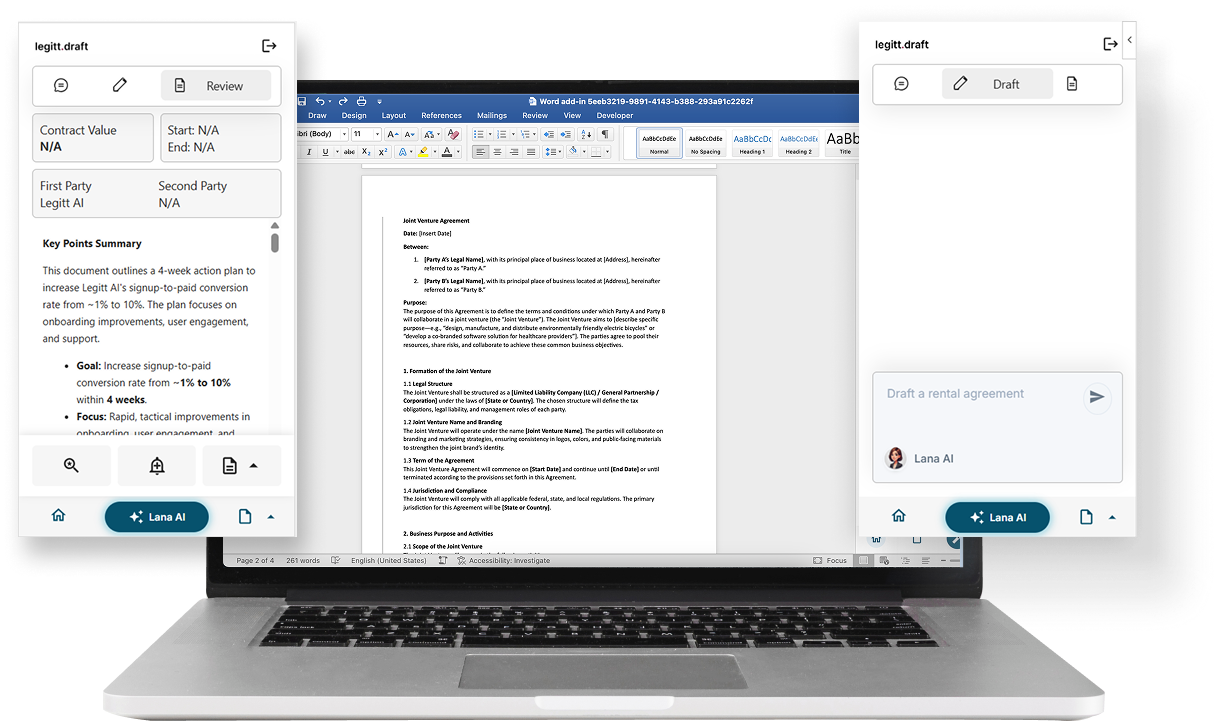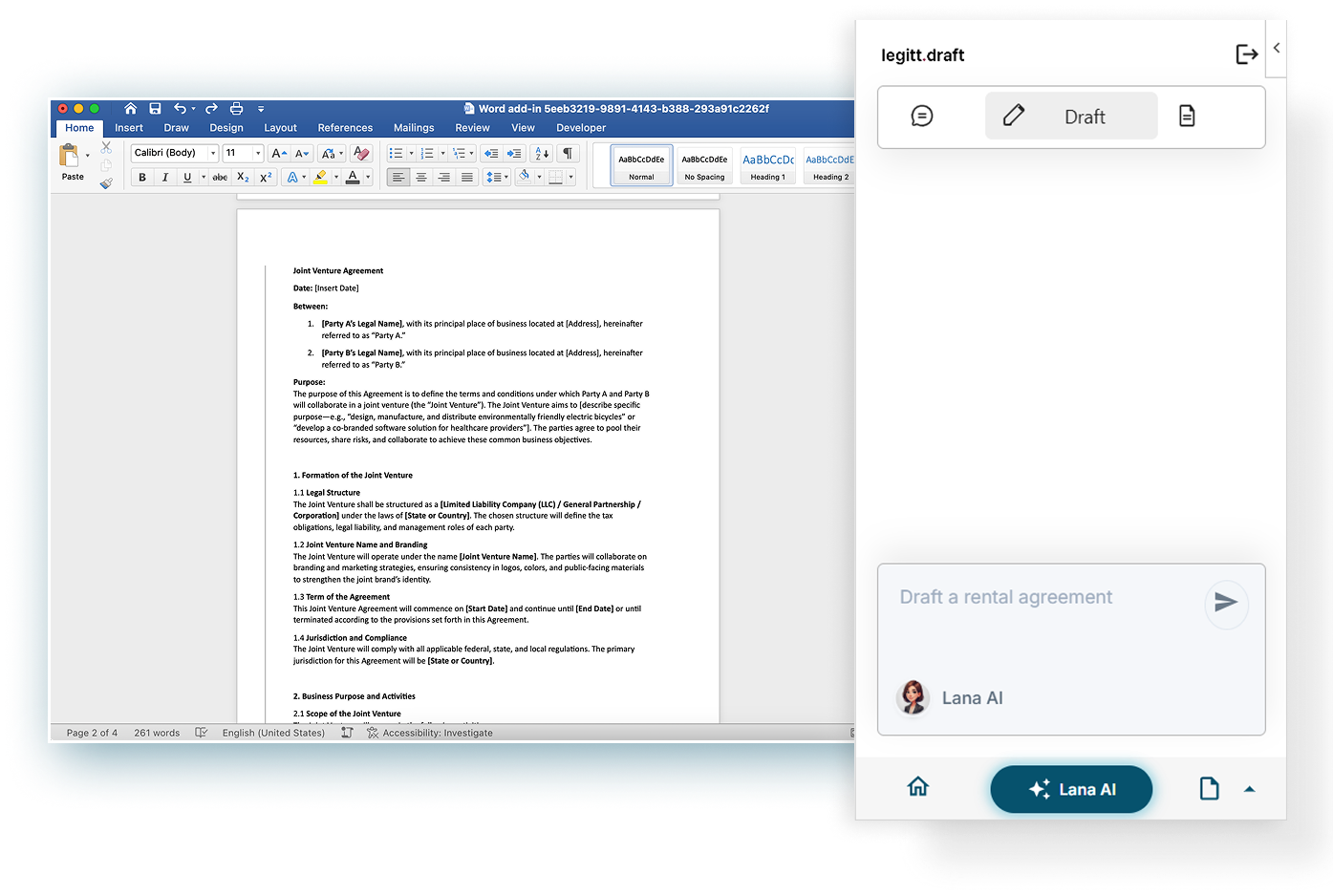In today’s fast-paced business environment, decision-makers cannot afford to wait days – or even hours – for traditional legal reviews. As businesses accelerate the pace of dealmaking, partnership negotiations, and contract execution, traditional legal risk analysis processes often become bottlenecks. The need for instant legal insights has never been greater.
Enter real-time legal risk analysis powered by AI. This transformative approach allows organizations to detect legal vulnerabilities, flag non-compliant clauses, and receive actionable suggestions – instantly. It redefines the way teams handle contracts, compliance, negotiations, and governance, bridging the gap between legal due diligence and business momentum.
Read More: No More Bottlenecks: How Legitt Draft Eliminates Legal Delays
The Legal Bottleneck Problem
Historically, legal review processes are time-consuming and labor-intensive. Teams must:
- Draft or receive a contract
- Send it for internal or external legal counsel
- Wait days or weeks for review
- Interpret feedback, and
- Iterate back and forth between business and legal teams
This delay often hampers strategic momentum. Sales deals slow down. Partnerships lose steam. Vendors seek other options. And businesses operate in risk-prone zones longer than necessary.

What Is Real-Time Legal Risk Analysis?
Real-time legal risk analysis uses AI-powered tools – often embedded directly within word processors or contract management platforms – to instantly analyze the content of legal documents. These systems detect clauses that:
- Violate company policy
- Conflict with regulatory compliance standards
- Increase exposure to financial or operational risks
- Include vague or missing terms
- Deviate from standard clause libraries
Instead of waiting for a legal team’s input, users receive detailed, clause-level feedback as they draft, edit, or upload contracts.
How It Works
The typical real-time legal analysis tool includes:
- Clause Recognition Engine: Uses natural language processing (NLP) to extract and classify clauses (e.g., indemnity, warranties, termination, confidentiality).
- Risk Scoring System: Assigns scores to each clause or contract based on deviation from safe standards.
- Compliance Checker: Matches clauses against internal policies, regulatory frameworks (like GDPR, HIPAA), and industry norms.
- Recommendations Engine: Suggests redlines, alternative wording, or required additions based on best practices or company-specific clause libraries.
- Learning Feedback Loop: Continuously improves as legal teams accept or override AI suggestions.
Benefits of Real-Time Legal Risk Analysis
1. Faster Deal Cycles
Contracts no longer sit idle in legal queues. Sales and procurement teams can move with confidence, having instant insight into legal implications.
2. Empowered Non-Legal Teams
Business users – like sales, HR, finance – gain autonomy. They can assess legal risk without waiting for formal legal opinions, and know when to escalate truly complex issues.
3. Reduced Legal Workload
Legal teams can focus on high-risk, high-value matters. Routine contract reviews are automated, freeing up lawyers for strategic input.
4. Increased Compliance
By enforcing clause standards and flagging regulatory gaps, the tool helps organizations stay audit-ready and reduces non-compliance penalties.
5. Consistent Standards
With standardized clause libraries and AI-driven enforcement, companies reduce contract variance and risk exposure.
Use Cases Across the Organization
Sales Teams
Close deals faster by validating terms in NDAs, MSAs, SOWs, and SLAs before involving legal.
Procurement
Quickly assess vendor terms and flag unfair liability, payment, or IP terms.
HR
Analyze employment agreements, NDAs, and contractor agreements on the fly.
Finance
Check funding agreements, investor contracts, and loan documents for red flags.
Startups & SMBs
Operate with confidence without maintaining a full-time legal team.
Why Now? The Technology is Ready
AI and LLMs (large language models) have matured. Tools like OpenAI’s GPT-4 and advanced contract parsing frameworks can read, understand, and interpret legal documents with near-human comprehension. With secure infrastructure and legal-specific fine-tuning, they now deliver dependable, actionable results.
Solutions like Legitt Draft, for example, integrate directly into Microsoft Word – bringing real-time risk analysis, clause suggestions, and compliance insights directly into the drafting environment. This seamless integration eliminates context-switching and enhances adoption across teams.
Risks Without Real-Time Review
Operating without this capability exposes your organization to:
- Unfavorable Terms: You may agree to clauses that shift undue risk.
- Compliance Failures: Missing regulatory terms (e.g., data handling policies) can lead to penalties.
- Deal Delays: Waiting for legal reviews may result in lost opportunities.
- Contract Sprawl: Inconsistent terms across contracts create chaos and risk in the long term.
How Legal Teams Benefit
Contrary to the misconception that AI replaces legal teams, real-time analysis augments them. Legal departments gain:
- Pre-screened contracts, so only complex/high-risk items reach them
- Visibility into deviation patterns, helping refine contract templates
- Fewer review cycles, improving team productivity
- Improved collaboration, as AI explains risks in plain English
Legal teams become enablers, not blockers – guiding the business with greater speed and impact.
Draft & Review Contracts 10x Faster – With Zero Hassle
Donload Now
The Future of Legal Risk Analysis
Legal risk analysis is becoming embedded, intelligent, and intuitive. In the near future, expect:
- Conversational legal assistants that can answer contract-related questions instantly.
- Cross-system integrations that pull in CRM, finance, and policy data to contextualize risk.
- AI-suggested redlines that legal can review and approve in bulk.
- Contract version comparisons with change impact analysis.
- Live negotiation assistants that alert users when terms deviate during vendor or customer calls.
Conclusion
The age of waiting days for legal reviews is over.
Real-time legal risk analysis empowers businesses to move faster, make informed decisions, and maintain control – without sacrificing compliance or legal safety. With tools like Legitt Draft and other AI-enabled legal technologies, companies can draft, review, and improve contracts in seconds – not days.
The result? A future where legal becomes a seamless part of business – not a bottleneck.
Did you find this article worthwhile? More engaging blogs and products about smart contracts on the blockchain, contract management software, and electronic signatures can be found in the Legitt AI. You may also contact Legitt to hire the best contract lifecycle management services and solutions, along with free contract templates.
FAQs on Legal Risk Analysis
What is real-time legal risk analysis?
Real-time legal risk analysis refers to the instant evaluation of legal documents using AI-powered tools. These tools detect risks, highlight compliance issues, and provide clause-level feedback without needing a manual legal review. This allows business teams to work faster and smarter.
How does real-time risk analysis compare to traditional legal reviews?
Traditional reviews are slower and rely on manual input from legal professionals. Real-time systems offer instant, automated feedback while drafting or uploading a contract. While they don’t replace legal counsel, they act as a first layer of defense and dramatically reduce turnaround time.
Is this technology reliable enough to trust without legal involvement?
Yes, modern tools use advanced AI models trained on millions of legal documents. While complex or high-risk contracts should still involve legal experts, most routine contracts can be confidently reviewed using real-time analysis tools. They also flag when legal review is needed.
What kinds of risks can AI detect in contracts?
AI tools can detect vague language, missing clauses, non-standard terms, overexposed liability, compliance gaps, and misaligned termination or payment terms. They can also score clauses based on risk and suggest alternatives from approved clause libraries.
How does this benefit legal teams?
Legal teams can offload repetitive tasks and focus on strategic, high-risk work. These tools reduce the review volume, improve consistency across contracts, and provide visibility into where teams need the most support. It’s an augmentation - not a replacement.
Can non-legal professionals use these tools easily?
Absolutely. Tools like Legitt Draft are designed with intuitive UIs and are embedded in familiar platforms like Microsoft Word. The feedback is delivered in plain English, often with clear visual cues and suggestions, making it easy for non-lawyers to take action.
How does this improve compliance?
By enforcing internal clause standards and automatically flagging missing or risky language, these tools ensure contracts adhere to regulatory and company-specific compliance rules. It reduces the likelihood of violations and helps maintain an audit-ready state.
Is the data processed by these tools secure?
Yes. Leading tools comply with industry security standards like SOC2, GDPR, and ISO. Sensitive data is processed with encryption, and many platforms offer on-prem or private cloud deployment options for added control.
What happens when the AI detects a high-risk clause?
The tool flags it immediately, explains why it's risky, and suggests alternate wording or the need for legal escalation. Users can decide to accept, modify, or send it to the legal team for further review - streamlining the entire process.
Will this replace lawyers in the future?
No. AI tools support and amplify the work of legal professionals - they don't replace them. They serve as intelligent assistants that increase speed, consistency, and accuracy, while lawyers continue to handle complex negotiations, regulatory interpretation, and nuanced strategy.
